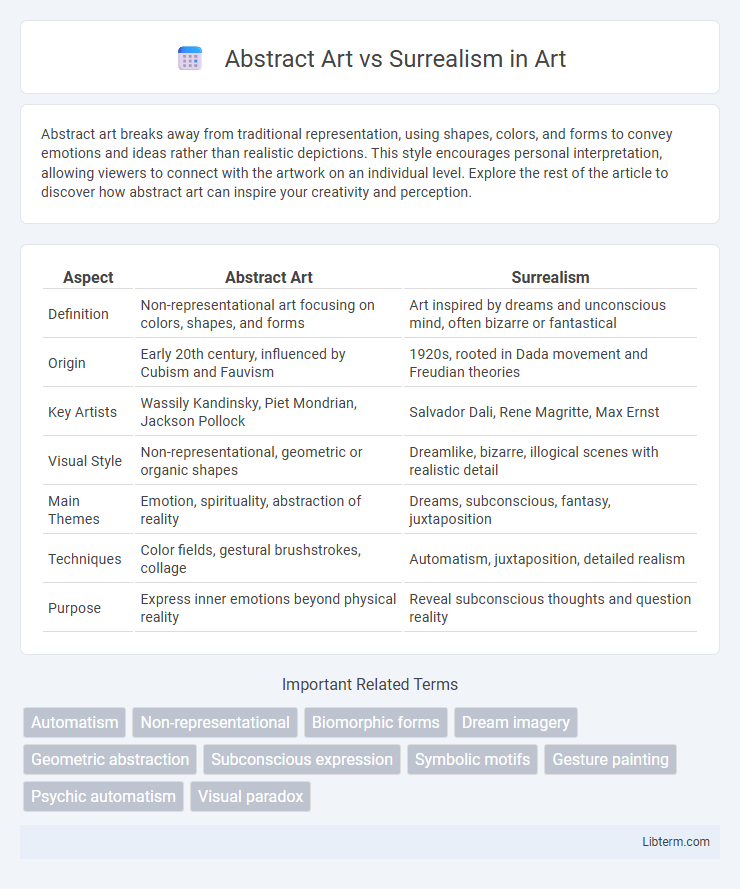Abstract art breaks away from traditional representation, using shapes, colors, and forms to convey emotions and ideas rather than realistic depictions. This style encourages personal interpretation, allowing viewers to connect with the artwork on an individual level. Explore the rest of the article to discover how abstract art can inspire your creativity and perception.
Table of Comparison
| Aspect | Abstract Art | Surrealism |
|---|---|---|
| Definition | Non-representational art focusing on colors, shapes, and forms | Art inspired by dreams and unconscious mind, often bizarre or fantastical |
| Origin | Early 20th century, influenced by Cubism and Fauvism | 1920s, rooted in Dada movement and Freudian theories |
| Key Artists | Wassily Kandinsky, Piet Mondrian, Jackson Pollock | Salvador Dali, Rene Magritte, Max Ernst |
| Visual Style | Non-representational, geometric or organic shapes | Dreamlike, bizarre, illogical scenes with realistic detail |
| Main Themes | Emotion, spirituality, abstraction of reality | Dreams, subconscious, fantasy, juxtaposition |
| Techniques | Color fields, gestural brushstrokes, collage | Automatism, juxtaposition, detailed realism |
| Purpose | Express inner emotions beyond physical reality | Reveal subconscious thoughts and question reality |
Introduction to Abstract Art and Surrealism
Abstract art emphasizes visual language through shapes, colors, and forms without depicting recognizable objects, enabling emotional expression and conceptual exploration. Surrealism, rooted in the early 20th century, taps into the subconscious mind by combining dreamlike imagery with unexpected juxtapositions to challenge reality. Key figures include Wassily Kandinsky for abstract art and Salvador Dali for surrealism, each shaping modern art paradigms through distinct philosophies.
Origins and Historical Background
Abstract Art emerged in the early 20th century as a response to representational art, emphasizing shapes, colors, and forms to evoke emotions without depicting recognizable objects. Surrealism originated in the 1920s, rooted in the Dada movement and influenced by Freudian psychoanalysis, aiming to unleash the unconscious mind through dreamlike and fantastical imagery. Both movements challenged traditional artistic conventions but diverged in focus: Abstract Art prioritized pure abstraction, while Surrealism explored the intersection of reality and the subconscious.
Core Philosophies and Influences
Abstract Art emphasizes the expression of emotions and ideas through non-representational forms, prioritizing color, shape, and texture to evoke subjective experiences. Surrealism, rooted in Freudian psychoanalysis, seeks to unlock the unconscious mind by blending dreamlike imagery with reality, often challenging rationality and logic. Both movements revolutionized 20th-century art by rejecting traditional representation, yet Abstract Art centers on internal emotional states while Surrealism explores the subconscious and irrational.
Key Characteristics of Abstract Art
Abstract art emphasizes non-representational forms, vibrant colors, and dynamic shapes to evoke emotions and ideas without depicting real objects. Key characteristics include the use of geometric or organic shapes, lack of recognizable subjects, and a focus on texture, line, and color interplay. This art form often prioritizes personal expression and explores the boundaries of visual perception and interpretation.
Defining Features of Surrealism
Surrealism is characterized by its exploration of the unconscious mind, featuring dream-like scenes, unexpected juxtapositions, and illogical landscapes that challenge reality. It emphasizes automatism, symbolism, and the liberation of imagination to access deeper psychological truths. Unlike Abstract Art, which focuses on form, color, and non-representational shapes, Surrealism prioritizes narrative and symbolic content rooted in Freudian theory.
Prominent Artists and Iconic Works
Abstract art features key figures like Wassily Kandinsky, whose work "Composition VII" epitomizes non-representational forms and vibrant color interplay. Surrealism includes iconic artists such as Salvador Dali, renowned for "The Persistence of Memory," which explores dreamlike, bizarre scenes through meticulous realism. Both movements revolutionized 20th-century art, with abstract art emphasizing emotional expression and surrealism focusing on unconscious mind imagery.
Techniques and Materials Used
Abstract art primarily employs techniques such as color field painting, geometric shapes, and spontaneous brushwork, often utilizing acrylics, oils, and mixed media on canvas to emphasize form and color over realistic representation. Surrealism relies on methods like automatic drawing, collage, and detailed realism combined with dreamlike imagery, frequently using oil paints, photography, and unconventional materials to evoke subconscious experiences. Both movements experiment with texture and layering, but surrealism integrates symbolic objects and complex juxtapositions, while abstract art focuses on pure visual elements and emotional expression.
Impact on Modern and Contemporary Art
Abstract art revolutionized visual expression by emphasizing color, form, and emotion, shaping the trajectory of modern and contemporary art through its break from representational accuracy. Surrealism introduced the exploration of the unconscious mind, dreams, and irrational juxtapositions, profoundly influencing movements like Abstract Expressionism and conceptual art. Together, these styles expanded artistic boundaries, fostering experimentation and new interpretive possibilities in 20th and 21st-century art.
Common Misconceptions and Differences
Abstract art is often mistaken for surrealism due to its departure from realistic representation, yet it focuses on shapes, colors, and forms without depicting recognizable objects, while surrealism explores dreamlike, bizarre scenes rooted in the unconscious mind. Abstract art emphasizes non-representational aesthetics, whereas surrealism combines realistic elements in illogical or fantastical ways to evoke subconscious thoughts. Common misconceptions include confusing abstract art's ambiguity with surrealism's narrative-like imagery and misunderstanding surrealism as purely abstract or random instead of symbolically rich and psychologically driven.
Legacy and Continuing Evolution
Abstract art revolutionized visual expression by prioritizing form, color, and emotion over realistic representation, influencing modern art movements and contemporary digital creations. Surrealism's legacy persists through its exploration of the unconscious mind and dream imagery, inspiring literature, film, and experimental art practices. Both movements continue to evolve as artists integrate new technologies and cultural narratives, expanding their impact on global artistic innovation.
Abstract Art Infographic

 libterm.com
libterm.com